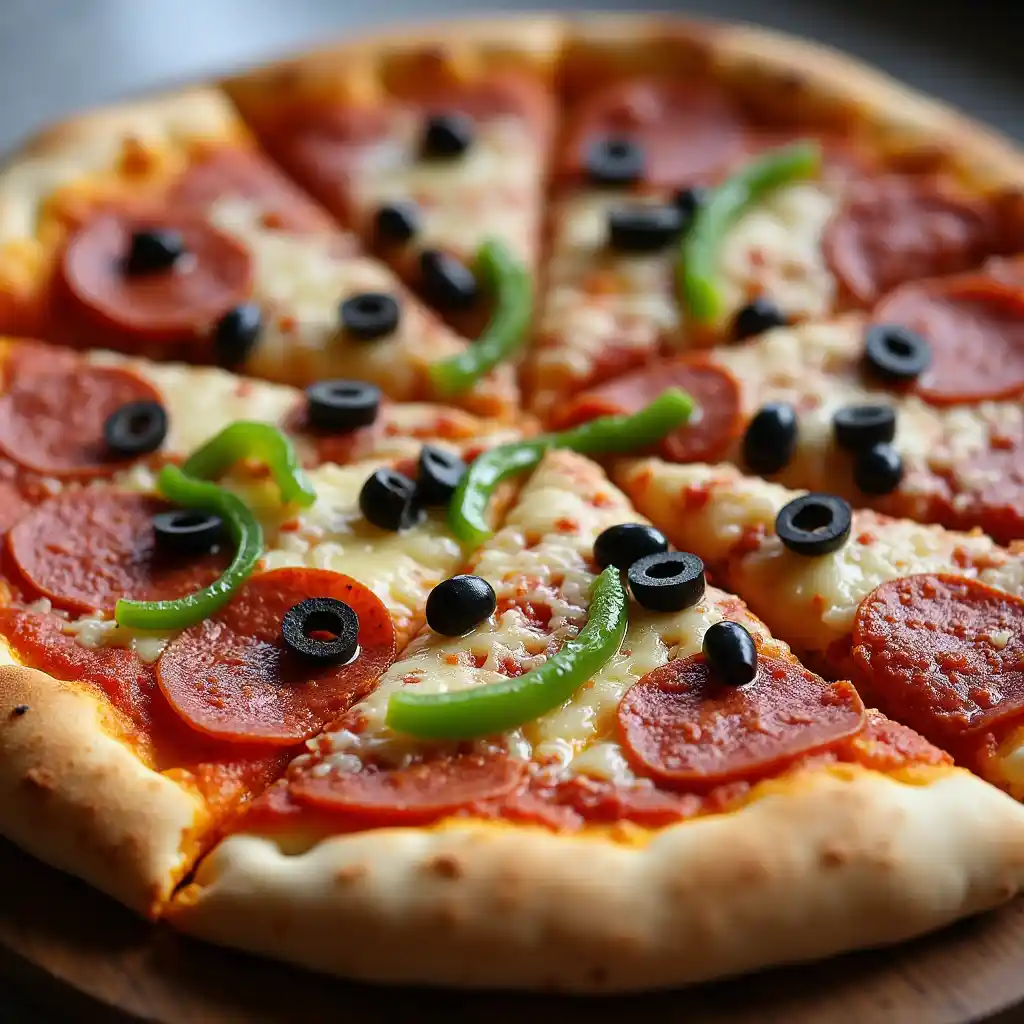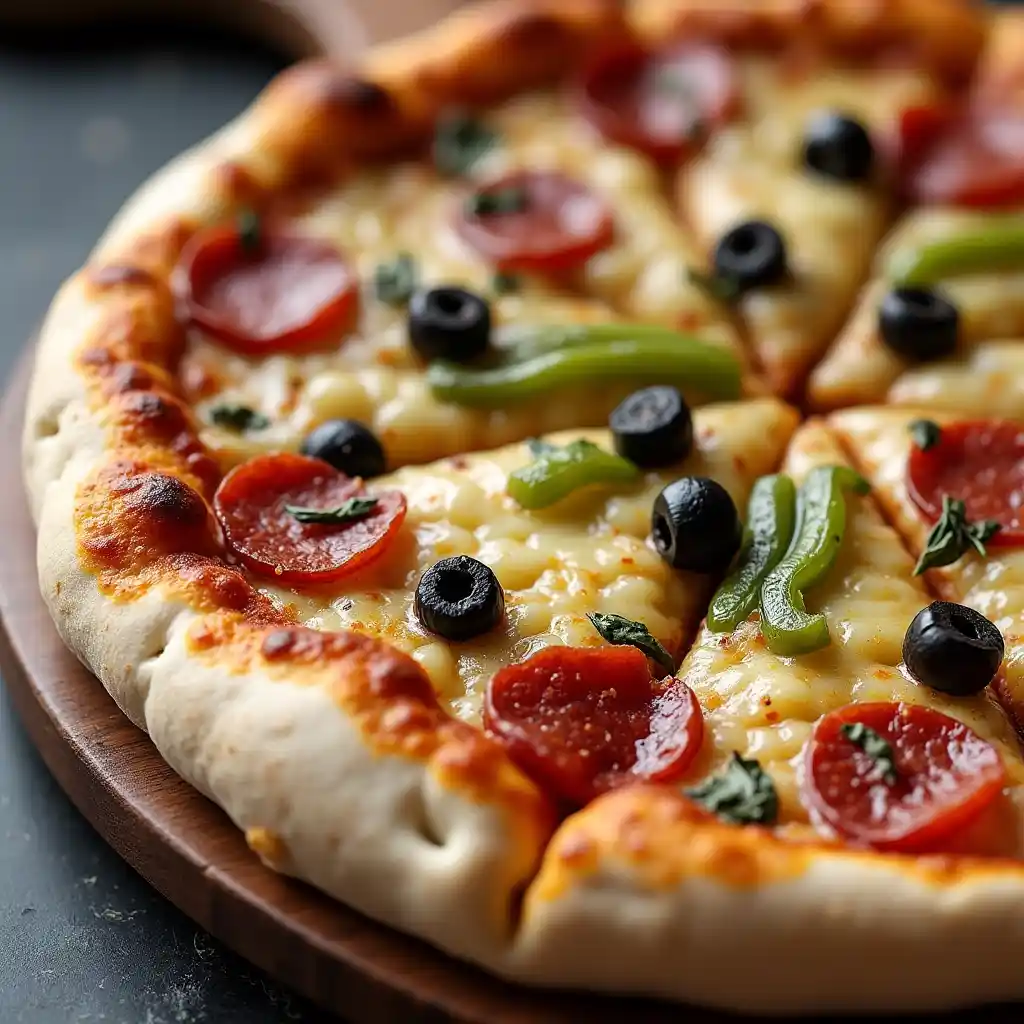If you’ve ever craved homemade pizza but found yourself without yeast, you’re not alone and you’re not out of options. A no-yeast pizza crust is a quick, simple alternative that skips the proofing time but delivers big on flavor and satisfaction. Instead of relying on yeast for leavening, this dough uses baking powder or baking soda to create a light, crisp base that’s ready in minutes.
Hi! I’m Chef Olivia a professionally trained chef, recipe developer, and lifelong food lover. I first stumbled upon this recipe in a moment of desperation during a quiet Sunday afternoon, craving pizza but without a packet of yeast in sight. It reminded me of the improvisational spirit I learned in my grandmother’s kitchen, where creativity and heart mattered more than perfect ingredients.
This recipe is born from that spirit simple, fast, and perfect for when you want pizza now without compromising on quality or taste.

Table of Contents
Table of Contents
Understanding No-Yeast Pizza Dough
To appreciate no-yeast pizza dough, it helps to understand what yeast brings to the table in traditional recipes. Yeast is a living organism that feeds on sugars in the flour, producing carbon dioxide in the process. This gas gets trapped in the dough’s gluten structure, causing it to rise and develop a chewy, airy texture. The slow fermentation also adds complexity to the flavor—giving yeast-based crusts their signature tang and depth.
No-yeast pizza dough takes a different approach. Instead of biological fermentation, it uses chemical leaveners like baking powder or a mix of baking soda and an acid (such as lemon juice, yogurt, or vinegar). These ingredients react quickly to form bubbles, giving the dough lift without the need for resting or rising time.
The result? A pizza crust that’s ready in a fraction of the time. While it may not have the same elastic chewiness or fermented flavor of a yeasted dough, no-yeast crusts are often thinner, crisper, and pleasantly neutral in taste perfect for letting your toppings shine. This style of dough is ideal for busy weeknights, impromptu dinners, or anyone looking for a faster, simpler way to enjoy homemade pizza.

Essential Ingredients for No-Yeast Pizza Dough
No-yeast pizza dough is beautifully simple, relying on a handful of pantry staples you likely already have. The core ingredients include:
- All-purpose flour – the base of the dough, offering structure.
- Baking powder – the leavening agent that helps the crust rise.
- Salt – enhances flavor.
- Olive oil – adds richness and helps create a tender texture.
- Water or milk – brings the dough together and provides moisture.
To elevate the flavor and texture, you can add a small pinch of sugar to promote browning and a hint of sweetness. Some cooks also mix in garlic powder, Italian herbs, or grated cheese directly into the dough for extra depth.
For dietary preferences, substitutions are easy: use gluten-free flour blends for a gluten-free option (add xanthan gum if needed), or swap in plant-based milk like almond or oat for a dairy-free version. The flexibility of this dough makes it accessible for nearly every home cook.Step-by-Step Guide to Making No-Yeast Pizza Dough
Print
Easy No-Yeast Pizza Crust Recipe
- Total Time: 25 mins
- Yield: 1 (12-inch) pizza crust
Description
This no-yeast pizza dough is quick to make and bakes up into a tender and tasty crust for your favorite pizza toppings.
Ingredients
-
1 ⅓ cups all-purpose flour
-
1 teaspoon baking powder
-
½ teaspoon salt
-
½ cup fat-free milk
-
2 tablespoons olive oil
Instructions
step 1
Gather all ingredients.
step 2
Mix flour, baking powder, and salt together in a bowl; stir in milk and olive oil until a soft dough forms.
step 3
Turn dough onto a lightly floured surface and knead 10 times. Shape dough into a ball; cover with an inverted bowl and let sit for 10 minutes. Meanwhile, preheat the oven to 400 degrees F (200 degrees C).
step 4
Roll dough into a 12-inch circle on a baking sheet.
step 5
-
Bake the crust in the preheated oven for 8 minutes.
-
step 6
-
Add your favorite toppings and bake until the crust is golden brown, about 10 to 15 minutes more. Enjoy!
Notes
No yeast? No problem! This no-yeast pizza dough recipe is not only quicker than traditional dough, it yields perfect homemade pizza crust every time!
- Prep Time: 15 mins
- Cook Time: 10 mins
- Category: lunch and dinner
- Method: simple
- Cuisine: italy
Nutrition
- Serving Size: 8
- Calories: 112
- Sugar: 0
- Sodium: 0
- Fat: 4g
- Saturated Fat: 0
- Unsaturated Fat: 0
- Trans Fat: 4g
- Carbohydrates: 17g
- Fiber: 0
- Protein: 3g
- Cholesterol: 0
Keywords: Olive oil, fat free, baking powder, all purpose flour
Step-by-Step Guide to Making No-Yeast Pizza Dough
Making no-yeast pizza dough is quick, easy, and doesn’t require any rising time. Here’s how to do it from scratch:
Ingredients
- 2 cups all-purpose flour
- 2 ½ tsp baking powder
- ¾ tsp salt
- ¾ cup water (or milk)
- 2 tbsp olive oil
Step 1: Mix the Dry Ingredients
In a large mixing bowl, whisk together the flour, baking powder, and salt. Mixing these first ensures the leavening agent is evenly distributed, preventing uneven rising.
Step 2: Add the Wet Ingredients
Pour in the water (or milk) and olive oil. Stir with a spoon or rubber spatula until a shaggy dough forms. If the dough feels dry, add a teaspoon of water at a time. If it’s sticky, sprinkle in a little extra flour.
Step 3: Knead the Dough
Turn the dough out onto a lightly floured surface and knead it gently for about 2–3 minutes. The dough should come together smoothly without being overly sticky or tough. Avoid over-kneading—it can make the crust dense.
Step 4: Optional Resting Time
Though not essential, letting the dough rest for 5–10 minutes (covered with a towel) can improve elasticity and make it easier to roll out.
Step 5: Roll and Shape
Divide the dough if making individual pizzas. Use a rolling pin or your hands to flatten the dough into your desired shape—round, rectangle, or rustic freeform. Aim for about ¼ inch thickness for a balanced crust. For a thinner, crisper base, roll it even thinner.
Dust the surface lightly with flour to prevent sticking, and transfer the rolled dough to a baking sheet or pizza stone before topping and baking.
Baking the Perfect No-Yeast Pizza Crust
Baking your no-yeast pizza dough correctly is key to getting that perfect balance of crispiness and chew. Start by preheating your oven to 450–475°F (230–245°C)—a hot oven ensures the crust cooks quickly and evenly, developing a golden, slightly crisp bottom without drying out.
If you have a pizza stone, place it in the oven while it preheats. This helps replicate the high, direct heat of a pizza oven, giving you a beautifully blistered base. If you’re using a baking sheet, lightly oil or line it with parchment paper to prevent sticking and aid browning.
Once your dough is rolled out and topped, bake it on the lowest rack for about 12–15 minutes, or until the crust is golden brown and the cheese is bubbling. If using a stone, transfer the pizza using a peel or an inverted baking sheet for best results.
To achieve a crispy exterior and tender interior, avoid overloading the pizza with toppings—too much moisture can make the crust soggy. Brushing the edges with olive oil before baking can also enhance browning and add a pleasant crunch. Let the pizza cool slightly before slicing to keep the crust intact and the flavors settled.
Variations and Creative Twists
One of the best things about no-yeast pizza dough is how versatile it is. With a few tweaks, you can customize the dough to suit your tastes or get creative with entirely new dishes.
1. Add Herbs and Spices to the Dough
Mixing dried herbs like oregano, basil, rosemary, or thyme directly into the flour adds aromatic depth. For extra flavor, try garlic powder, onion powder, or even a touch of crushed red pepper flakes for heat. A teaspoon or two is enough to transform a basic dough into something special.
2. Try Alternative Flours
Switching up the flour changes both texture and nutrition. Use whole wheat flour for a nuttier, denser crust with added fiber, or blend it 50/50 with all-purpose for balance. Almond flour adds a subtle sweetness and works well for gluten-free versions—though it’s best combined with a binder like tapioca starch or a gluten-free flour mix for structure.
3. Get Creative with Crust Edges
Brush the edges with garlic butter, herb oil, or grated cheese before baking to boost flavor and create golden, crisp crusts. You can also make stuffed crusts by wrapping cheese sticks or shredded cheese into the dough’s perimeter—seal tightly to avoid leaks.
4. Beyond Pizza: Calzones and Flatbreads
This dough is adaptable! Use it to make calzones, stuffed with meats, cheeses, and vegetables, or roll it thinner for flatbreads, ideal as a side for dips, soups, or salads.
These creative twists let you turn a simple recipe into something truly personalized and exciting.
Common Mistakes and How to Avoid Them
Even with a simple recipe like no-yeast pizza dough, small missteps can affect the final result. Here are some common pitfalls—and how to avoid them:
1. Overworking the Dough
Kneading too much can make the crust dense and tough. Unlike yeast dough, which benefits from gluten development, no-yeast dough only needs a gentle mix until smooth. Aim for 2–3 minutes of light kneading—just enough to bring everything together.
2. Incorrect Measurements
Too much flour makes the dough dry and crumbly, while too little makes it sticky and hard to handle. Use the spoon-and-level method to measure flour accurately, and adjust liquids gradually as you mix. A kitchen scale provides the most precision.
3. Baking at Too Low a Temperature
A cool oven won’t give you that golden, crisp crust. Always preheat your oven to 450–475°F (230–245°C) and bake on the lowest rack. This ensures quick cooking, even browning, and avoids a soggy bottom.
Mastering these basics sets you up for consistently great results.
Serving Suggestions and Topping Ideas
No-yeast pizza crusts provide a neutral, crisp canvas that pairs beautifully with a wide variety of toppings. Their slightly lighter texture makes them especially well-suited for fresh, bold flavors.
Classic Favorites
Start with timeless combinations like pepperoni and mozzarella, mushroom and onion, or a simple Margherita with tomato sauce, fresh mozzarella, and basil.
Vegetarian & Vegan Ideas
For a plant-forward pizza, try toppings like roasted vegetables, artichoke hearts, sun-dried tomatoes, spinach, and vegan mozzarella or cashew cheese. A drizzle of balsamic glaze or pesto adds gourmet flair.
Meat-Lovers’ Options
Layer on Italian sausage, ham, bacon, or grilled chicken. Pair with caramelized onions or banana peppers for a sweet-and-savory kick.
Sauce & Cheese Pairings
While classic tomato sauce works beautifully, try white garlic sauce, pesto, or olive tapenade. As for cheese, experiment with goat cheese, fontina, provolone, or a sprinkle of parmesan to enhance flavor.
The possibilities are endless—make it your own!
Storing and Reheating Tips
To store leftover dough, wrap it tightly in plastic wrap or place it in an airtight container and refrigerate for up to 2 days. Bring to room temperature before rolling out. Baked pizza can be stored in the fridge for 3–4 days, wrapped in foil or stored in a sealed container.
For reheating, skip the microwave—it makes the crust soggy. Instead, use a skillet over medium heat to crisp the bottom, or reheat in a 400°F (200°C) oven for about 5–7 minutes. This helps restore the crust’s crispiness while warming the toppings evenly.
Conclusion
Making no-yeast pizza crust is a fantastic way to enjoy homemade pizza without the wait or complexity of yeast-based dough. It’s quick, accessible, and adaptable, perfect for busy nights or when you want a simple yet satisfying meal. With endless possibilities to experiment—whether adding herbs, trying alternative flours, or creating stuffed crusts—you can easily tailor this recipe to your taste and dietary needs. I encourage you to get creative in the kitchen and discover your favorite variations. And don’t forget to share your no-yeast pizza creations—there’s nothing better than celebrating great food with a community of fellow pizza lovers!
For more Recipes follow me in FACEBOOK and PINTEREST
FAQs
What can I use for pizza dough instead of yeast?
Instead of yeast, you can use baking powder or a combination of baking soda and an acid (like lemon juice or yogurt) as leavening agents. These create bubbles that help the dough rise quickly without fermentation.
Can we make pizza dough without yeast?
Yes! No-yeast pizza dough is a popular alternative that’s faster and simpler. It uses chemical leaveners to create a lighter crust and is perfect when you don’t have yeast on hand or want to avoid the waiting time.
What happens if you don’t put yeast in pizza dough?
Without yeast, the dough won’t ferment or develop the traditional airy texture and tangy flavor. Instead, it will be denser and crisper, often thinner and with a more neutral taste, allowing toppings to stand out more.
How to make pizza dough with 3 ingredients?
A basic no-yeast pizza dough can be made with just flour, baking powder, and water. Add salt and oil if you want more flavor and tenderness, but the bare minimum works for a quick, simple crust.

1 thought on “Easy No-Yeast Pizza Crust Recipe”
Comments are closed.